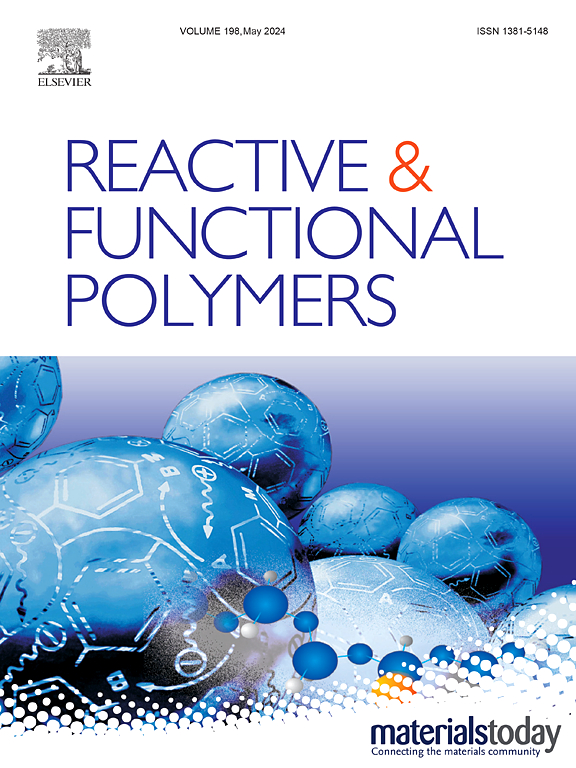Enhanced foaming performance of crosslinked poly(3-hydroxybutyrate-co-4-hydroxybutyrate)/poly(butylene adipate-co-terephthalate) blends via reactive chain extension
IF 5.1
3区 工程技术
Q1 CHEMISTRY, APPLIED
引用次数: 0
Abstract
This study investigates the enhanced foaming behavior of partially crosslinked blends of poly(3-hydroxybutyrate-co-4-hydroxybutyrate) [P(3HB-co-4HB)] with poly(butylene adipate-co-terephthalate) (PBAT) using a reactive modification strategy. The crosslinking process employed di-(tert-butylperoxyisopropyl)benzene (DTBPIB) as a radical initiator and triallyl isocyanurate (TAIC) as a coagent. The effects of varying TAIC content on gel fraction, rheological behavior, mechanical properties, and cellular morphology were systematically studied. The modified blends demonstrated significantly increased gel content and complex viscosity, particularly at low angular frequencies, indicating enhanced melt elasticity. Tensile tests revealed improved modulus and strength with increasing TAIC loading, suggesting network formation within the matrix. The foamed structures, prepared using a chemical blowing agent, exhibited higher expansion ratios and finer, more uniform cell morphologies in samples with both DTBPIB and TAIC. These results demonstrate that reactive crosslinking offers a promising route to engineer bio-based foams with improved mechanical integrity and foamability.

通过反应链扩展提高聚(3-羟基丁酸酯-co-4-羟基丁酸酯)/聚(己二酸丁酯-对苯二甲酸酯)交联物的发泡性能
本研究采用反应改性策略研究了聚(3-羟基丁酸酯-co-4-羟基丁酸酯)[P(3HB-co-4HB)]与聚(己二酸丁二酯-共对苯二甲酸酯)(PBAT)部分交联共混物的增强发泡行为。该交联工艺以二叔丁基过氧异丙基苯(DTBPIB)为自由基引发剂,异氰尿酸三烯丙基(TAIC)为助剂。系统地研究了不同的TAIC含量对凝胶分数、流变行为、机械性能和细胞形态的影响。改性共混物的凝胶含量和复合粘度显著增加,特别是在低角频率下,表明熔体弹性增强。拉伸试验显示,随着TAIC载荷的增加,模量和强度有所提高,表明基体内部形成了网状结构。使用化学发泡剂制备的泡沫结构在DTBPIB和TAIC样品中具有更高的膨胀率和更细,更均匀的细胞形态。这些结果表明,反应性交联为提高生物基泡沫的机械完整性和发泡性提供了一条有前途的途径。
本文章由计算机程序翻译,如有差异,请以英文原文为准。
求助全文
约1分钟内获得全文
求助全文
来源期刊

Reactive & Functional Polymers
工程技术-高分子科学
CiteScore
8.90
自引率
5.90%
发文量
259
审稿时长
27 days
期刊介绍:
Reactive & Functional Polymers provides a forum to disseminate original ideas, concepts and developments in the science and technology of polymers with functional groups, which impart specific chemical reactivity or physical, chemical, structural, biological, and pharmacological functionality. The scope covers organic polymers, acting for instance as reagents, catalysts, templates, ion-exchangers, selective sorbents, chelating or antimicrobial agents, drug carriers, sensors, membranes, and hydrogels. This also includes reactive cross-linkable prepolymers and high-performance thermosetting polymers, natural or degradable polymers, conducting polymers, and porous polymers.
Original research articles must contain thorough molecular and material characterization data on synthesis of the above polymers in combination with their applications. Applications include but are not limited to catalysis, water or effluent treatment, separations and recovery, electronics and information storage, energy conversion, encapsulation, or adhesion.
 求助内容:
求助内容: 应助结果提醒方式:
应助结果提醒方式:


